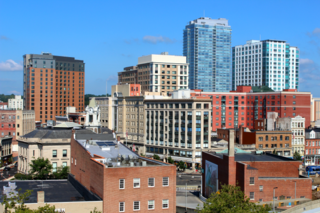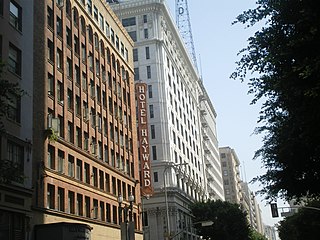
Atlanta City Hall is the headquarters of the City of Atlanta government. It was constructed in 1930, and is located in Downtown Atlanta. It is a high-rise office tower very similar to dozens of other city halls built in the United States during the same time period. Located in South Downtown, it is near other governmental structures, such as the Georgia State Capitol and the Fulton County Courthouse. The Neo-Gothic structure features many architectural details that have helped to make the building a historical landmark. It is Atlanta’s fourth city hall.

Downtown Stamford, or Stamford Downtown, is the central business district of the city of Stamford, Connecticut, United States. It includes major retail establishments, a shopping mall, a university campus, the headquarters of major corporations and Fortune 500 companies, as well as other retail businesses, hotels, restaurants, offices, entertainment venues and high-rise apartment buildings.

Woodmen Tower, now WoodmenLife Tower, is a 478-ft (146-m) high-rise building at 1700 Farnam Street in downtown Omaha, Nebraska, and headquarters of WoodmenLife insurance company. Construction began in 1966, with the tower being completed in 1969. The skyscraper rises 30 stories and was the tallest skyscraper in both Omaha and Nebraska for over 30 years, until the construction of the First National Bank Tower.

The history of Omaha, Nebraska, began before the settlement of the city, with speculators from neighboring Council Bluffs, Iowa staking land across the Missouri River illegally as early as the 1840s. When it was legal to claim land in Indian Country, William D. Brown was operating the Lone Tree Ferry to bring settlers from Council Bluffs to Omaha. A treaty with the Omaha Tribe allowed the creation of the Nebraska Territory, and Omaha City was founded on July 4, 1854. With early settlement came claim jumpers and squatters, and the formation of a vigilante law group called the Omaha Claim Club, which was one of many claim clubs across the Midwest. During this period many of the city's founding fathers received lots in Scriptown, which was made possible by the actions of the Omaha Claim Club. The club's violent actions led to the U.S. Supreme Court trial, Baker v. Morton, which led to the end of the organization.

The Jewell Building is a city landmark in North Omaha, Nebraska. Built in 1923, it is listed on the National Register of Historic Places. Located at 2221 North 24th Street, the building was home to the Dreamland Ballroom for more than 40 years, and featured performances by many touring jazz and blues legends, including Duke Ellington, Count Basie, Louis Armstrong, Dizzy Gillespie, and Lionel Hampton.

The Minne Lusa Residential Historic District is located in North Omaha, Nebraska. It is included on the National Register of Historic Places. According to the National Park Service, it is an "example of a substantial, affordable single-family residential development within the city limits that was platted, developed and constructed by a single firm between 1915 and 1941." The neighborhood is filled with bungalows, Craftsman, and other styles that were popular in the era. There are 540 properties in the neighborhood that contribute to the historic district, the other 167 do not. Minne Lusa Boulevard is a contributing structure.

Downtown Omaha is the central business, government and social core of the Omaha-Council Bluffs metropolitan area, U.S. state of Nebraska. The boundaries are Omaha's 20th Street on the west to the Missouri River on the east and the centerline of Leavenworth Street on the south to the centerline of Chicago Street on the north, also including the CHI Health Center Omaha. Downtown sits on the Missouri River, with commanding views from the tallest skyscrapers.

The Old Post Office was located at 16th and Dodge Streets in Omaha, Nebraska. Built in 1898, the building was demolished in 1966. During the process of being demolished the building, along with the Old City Hall, became a rallying force for historic preservation in Omaha.

The present Douglas County Courthouse is located at 1701 Farnam Street in Omaha, Nebraska, United States. Built in 1912, it was added to the National Register of Historic Places in 1979. Notable events at the courthouse include two lynchings and the city's first sit-in during the Civil Rights Movement. Five years after it was opened, the building was almost destroyed by mob violence in the Omaha Race Riot of 1919.

The Bee Building, later called the Peters Trust Building and finally the Insurance Building, was located at 17th and Farnam Streets in Downtown Omaha, Nebraska. It was an architectural landmark in early Omaha that was built in 1888 by newspaper editor Edward Rosewater to house his Omaha Bee newspaper as well as several other companies. A period review remarked that the building was "probably only second in the United States to that of the New York Herald."

The Paxton Hotel, formerly known as Paxton Manor and currently known as The Paxton, is located at 1403 Farnam Street in Downtown Omaha, Nebraska, United States. Designed by local architect Joseph G. McArthur, the current building was constructed in 1928, with its predecessor dating from 1882. Named for local businessman and community leader William A. Paxton, today the building houses luxury condominia. It is one of the few significant Art Deco structures in Omaha today. Among some of the prominent guests who stayed at the Paxton were Buffalo Bill Cody and William Jennings Bryan, as well as President William McKinley stayed at the Paxton during the Trans-Mississippi Exposition in 1898.

The Gottlieb Storz House is located in the Blackstone neighborhood of Midtown Omaha, Nebraska. Built in 1905 by Omaha beer magnate Gottlieb Storz, the mansion was designated an Omaha Landmark on December 21, 1982, and was listed in the National Register of Historic Places on August 7, 1974. It was included in the Gold Coast Historic District when the district was listed in the NRHP on March 14, 1997.
North 24th Street is a two-way street that runs south–north in the North Omaha area of Omaha, Nebraska. With the street beginning at Dodge Street, the historically significant section of the street runs from Cuming Street to Ames Avenue. A portion of North 24th is considered the "Main Street" of the Near North Side, and was historically referred to as "The Street of Dreams." The corridor is widely considered the heart of Omaha's African-American community.

Spring Street in Los Angeles is one of the oldest streets in the city. Along Spring Street in Downtown Los Angeles, from just north of Fourth Street to just south of Seventh Street is the NRHP-listed Spring Street Financial District, nicknamed Wall Street of the West, lined with Beaux Arts buildings and currently experiencing gentrification. This section forms part of the Historic Core district of Downtown, together with portions of Hill, Broadway, Main and Los Angeles streets.
Mendelssohn, Fisher and Lawrie was a significant architecture firm in early Omaha, Nebraska. Fisher & Lawrie continued. A number of their works are listed on the National Register of Historic Places.
The Omaha Public Library in Omaha Nebraska currently has 12 locations.
The Minne Lusa Pumping Station was located along John J. Pershing Drive in the Florence neighborhood of North Omaha, Nebraska. The station, which was surrounded by settling basins, was the main source for pumping, filtering, and distributing Missouri River water throughout the City of Omaha. The station was the namesake of the Minne Lusa neighborhood located immediately to the south.

The former Woodmen of the World Building in Omaha, Nebraska, was located at 1323 Farnam Street. Built in 1912 by the architectural firms of Holibard and Roche and Fisher and Lawrie, the building was the headquarters of Woodmen of the World (WOW) from 1912 until 1934. WOW relocated in 1934 to the Bee Newspaper Building at 17th and Farnam, also known as the Insurance Building.
















